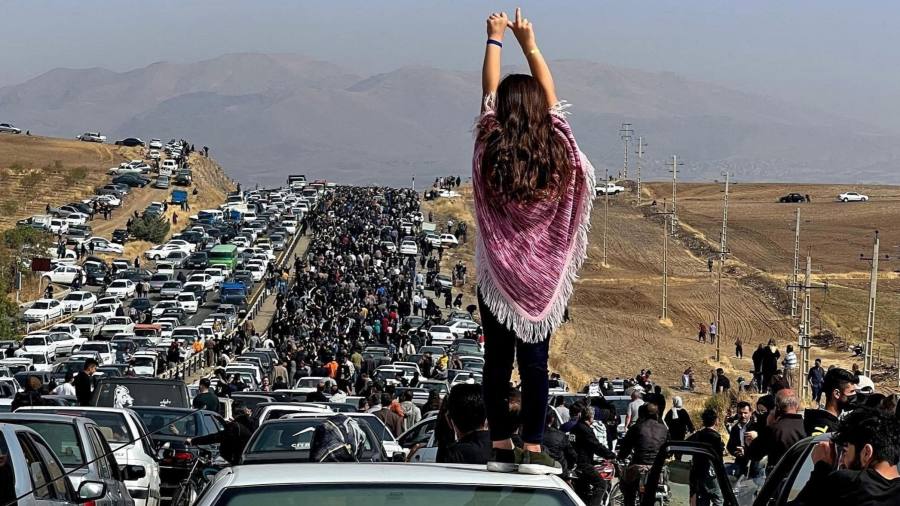
Receive free Iran updates
We’ll send you a myFT Daily Digest email rounding up the latest Iran news every morning.
The writer is author of ‘Black Wave’
Just as suddenly as they started in September, after the death of 22-year-old Mahsa Amini in police custody, the large protests that engulfed more than 150 cities and towns across Iran seemed to disappear around the start of the year. Gone also are the rallies by thousands of Iranians in the diaspora from Berlin to Ottawa and Los Angeles. Western artists are no longer cutting their hair and clamouring “Woman, Life, Freedom” in public displays of support for a protest movement that was the most the serious challenge to the Islamic Republic since the 2009 Green Revolution.
Away from the headlines, the war of attrition against the regime continues. Billboards set on fire. Women walking the streets unveiled, staring down hijab enforcers or spraying graffiti on the walls. Scattered protests in distant provinces. But the momentum is gone, for now. This is the typical cycle of ebb and flow in protest movements around the world.
In Iran, the gap between each surge and decline is getting shorter. The regime knows this is only a momentary reprieve. It has been trying to buy time and stability, making minor compromises while instilling more fear and resorting to diplomacy to regain some legitimacy. The regime’s key concern is ensuring a smooth succession to the 84-year-old supreme leader, Ayatollah Ali Khamenei, when the time comes.
Karim Sadjadpour of the Carnegie Endowment for International Peace described it as a stalemate between “a geriatric ruling theocracy incapable of reform and a young society tired of living under a bankrupt, socially repressive police state”. Sixty per cent of Iranians are under 30.
Just as events aligned to feed the protests, a confluence of different elements brought about this pause. Faced with mass arrests and deadly brutality, including police purposely shooting protesters in the eyes, the crowds retreated. At least 500 people were killed. The authorities are also on an execution binge to spread terror. Rapper Toomaj Salehi — whose fearless lyrics are the voice of a generation — has been in solitary confinement since his arrest in October. His trial finally took place behind closed doors over two sessions in the past 10 days. The 32-year-old is charged with “corruption on earth” and could face the death penalty. “We see the light after this hell . . . neither suppression, laws or executions can stop us,” he raps in his song, The Battlefield. No one can predict the next spark.
In early February, opposition figures in exile came together to announce a coalition working on a charter for the future of Iran. It appeared to be the first credible effort in decades to bring unity to a disparate diaspora, including Reza Pahlavi, Iran’s former crown prince, Masih Alinejad, one of the most prominent activists against the regime and compulsory hijab and Shirin Ebadi, Nobel Peace laureate. Divisions between monarchists and secular democrats fed by the rightwing, often aggressive entourage of Pahlavi meant that the coalition fell apart within a month. The regime is also thought to have deployed divide and rule tactics to sabotage the effort.
Iranians have been protesting for decades, with or without the diaspora. But to succeed, most street movements require international pressure or an opposition in exile or a combination of both, including Iran’s own 1979 revolution. A prominent anti-regime activist told me that the disappointment inside Iran was deep. “We are dying inside, and you are fighting each other,” was the message. Other alliances will form, learning the lessons of this experience.
With impeccable timing, just as the coalition was unravelling in March, Iran managed to break out of its isolation. Tehran and Riyadh announced they were restoring diplomatic ties after a seven-year break. Contacts with the west also resumed on the nuclear file and the release of dual citizens held in Iran. Tehran is hoping this diplomacy will bring economic deals or sanctions relief — money it can use to placate those driven to the streets by economic misery, separating them from the more activist and Gen-Z protesters. But so far, the diplomacy is only talk.
“The regime is dead. It just doesn’t know it yet.” These were the striking words of German-based Iranian artist Parastou Forouhar, after a visit to Tehran during the protests. The demise of the Islamic Republic of Iran has been predicted often, but its staying power for 44 years has defied all expectations. Yet something is irremediably broken. Iran feels febrile, every wave of protests building on the previous one. And the first anniversary of Amini’s death is fast approaching. Which elements will align for the next surge of dissent?